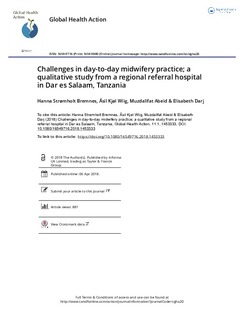| dc.description.abstract | Background: Maternal and infant mortality rates in Tanzania have decreased over the past decades, but remain high. One of the challenges the country faces, is the lack of skilled health care workers. High fertility rates make midwives and their patients particularly susceptible to stress as a result of understaffing.
Objective: This paper explores the challenges midwives face in their day-to-day practice at a regional referral hospital in Tanzania, and investigates which measures the midwives themselves find necessary to implement to improve their situation.
Methods: A qualitative study design with focus group discussions (FGDs) was employed to explore which challenges the midwives experienced. Each focus group consisted of five to six midwives. A FGD topic guide covering challenges, consequences, motivation, ideal situation and possible solutions was used. These data were analyzed using Systematic Text Condensation.
Results: A total of 28 Midwives, six men and 22 women, participated in five FGDs. Four categories emerged from the collected material: Feelings of demoralization, shortage of resources, societal challenges and personal struggles. A feeling of demoralization was especially prevalent and was caused by a lack of support from the leaders and little appreciation from the patients. Shortage of resources, and shortage of personnel in particular, was also highlighted as it led to an excessive workload resulting in difficulties with providing adequate care. These difficulties were intensified by lack of equipment, facilities and a non-optimal organization of the healthcare system.
Conclusion: The challenges revealed during the FGDs prevent the midwives from providing sufficient midwifery care. To improve the situation, measures such as supportive leadership, reduction of workload, increasing availability of equipment and increasing knowledge of reproductive health in society, should be taken. | nb_NO |

